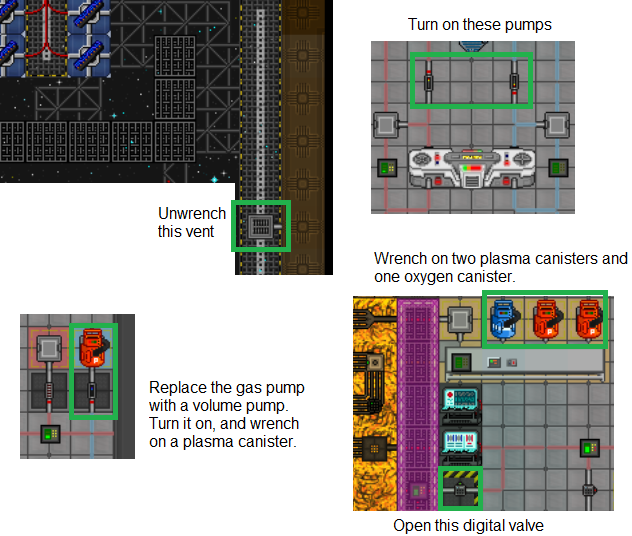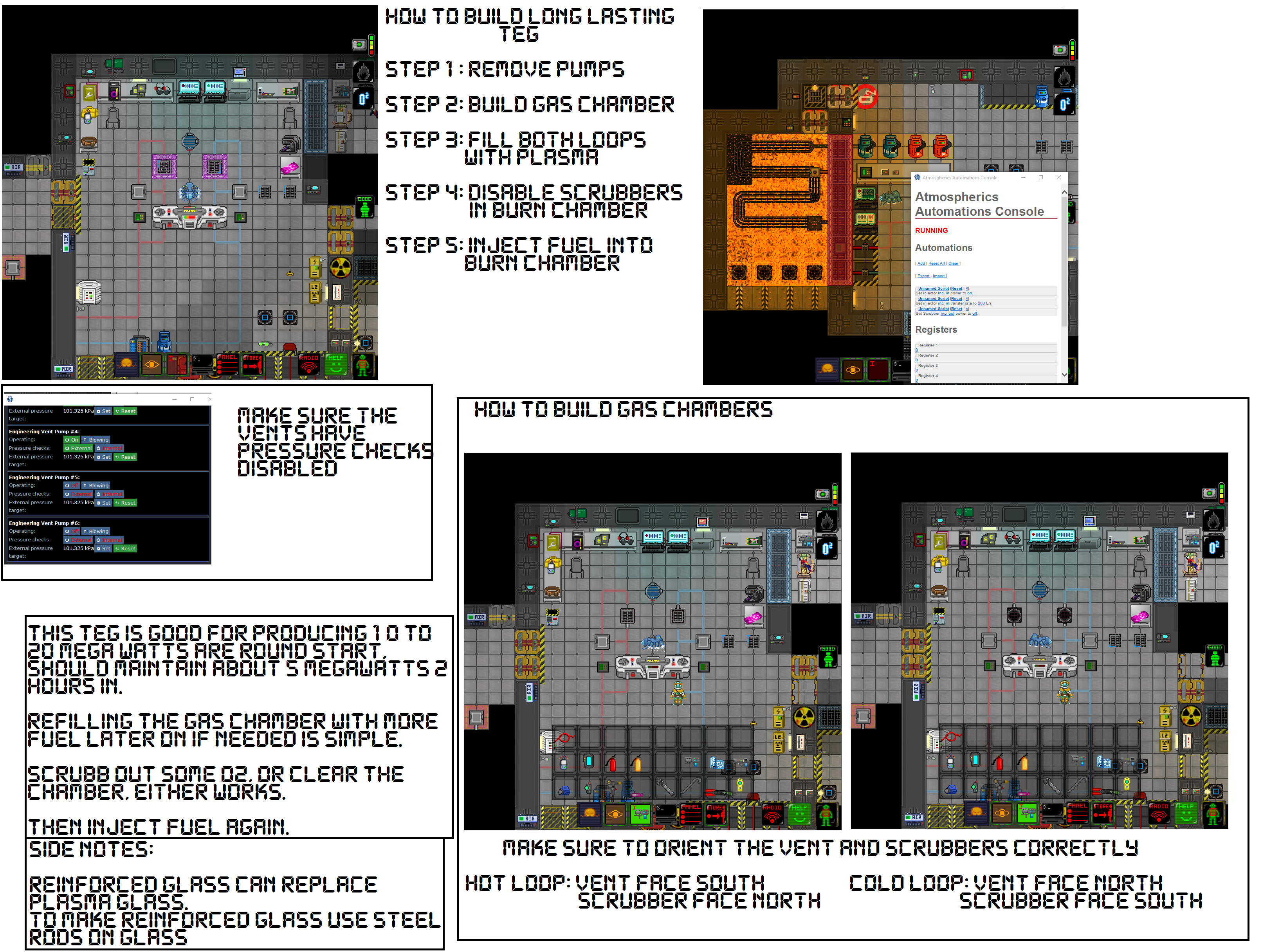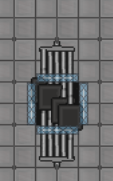Thermoelectric Generator: различия между версиями
(Новая страница: «== What is the Thermoelectric Generator? == The generator is a three-piece machinery item that consists of a generator, and two circulators. Extras can be ordered…») |
(нет различий)
|
Версия от 16:57, 26 февраля 2017
What is the Thermoelectric Generator?
The generator is a three-piece machinery item that consists of a generator, and two circulators. Extras can be ordered from cargo. Thermoelectric generators output power based on:
- Heat difference between the gas piped through the two circulators.
- Specific heat of the gases piped through the circulators.
- Flow rate.
While the 'hot' side and 'cold' side does not matter, the loops need to be very different in temperature. Their mols and pressure do not affect output, though may be significant to your build.
A working thermoelectric generator consists of
- A hot loop hooked into a burn chamber, to generate hot gas
- A cold loop, usually hooked to heat exchange pipes or thermal plates in space
- Gas inside the loops
- Two circulators anchored on either side of a generator
- A gate or pump to cause gas to direct flow
Setting up on Boxstation
Boxstation is the only station with a pre-fabricated Thermoelectric Generator. With very little effort and a negligible amount of risk, you can gain outputs of 5.75+ MW.
- Wrench on two plasma canisters and one oxygen canister to the ports near the burn chamber.
- Open the top digital valve near the burn chamber
- Unwrench the vent outside the burn chamber, in space to the left side, below the solars.
- Replace the gas pump into the cold line - located near the blue tile - with a volume pump. Wrench a plasma canister to that port and turn on the volume pump.
- Turn on both volume pumps near the generator itself.
Then, configure the computer.
- Delete the existing code on the Atmospherics Automatons Computer near the burn chamber. In its place, import this code:
[{"type":"/datum/automation/set_injector_power","injector":"inc_in","state":1},{"type":"/datum/automation/set_injector_rate","injector":"inc_in","rate":200},{"type":"/datum/automation/set_scrubber_gasses","scrubber":"inc_out","gasses":{"co2":0,"tox":1,"n2o":0,"o2":0,"n2":0}},{"type":"/datum/automation/set_scrubber_power","scrubber":"inc_out","state":1}]
- (Optional) Once the code is imported, toggle the scrubber's power to off. This will prevent the hot line from drawing in plasma, allowing it to heat up. You can toggle it back on after a couple minutes when the plasma is warmer. Around 3000 degrees is a good starting point.
- Click Stopped at the top of the interface, toggling it to Running. You should see the burn chamber flood with plasma, then catch on fire. If it doesn't catch on fire on its own, press the igniter button.
Maintenance
Like the Antimatter Engine, the Thermoelectric Generator requires regular maintenance. As your hot loop begins to cool, output will lower. It will take about half an hour for your output to die down fully.
Rebooting the generator is a simple process.
- Use the computer to turn off the injector.
- Remove the old cans and replace them with new cans in the same configuration.
- Press the 'vent' button, which will open the aft-facing blast shields. Wait for the chamber to empty fully. You can monitor its progress with the nearby tank monitoring computer.
- Close the shields and set the injector back to 'on'.
If it stops producing power
The most common cause of zero power output is flooding the hot loop. Volume pumps stop working at 9,000 kPa so if the hot loop goes above that threshold, the TEG will stop producing power entirely. Opening the bypass valve will reduce the pressure but will also reduce the temperature of the hot loop substantially. A better solution is to replace the bypass valve with a gas pump and pump hot gas into the cold loop until the hot loop goes back below 9000 kPa. Do not worry about warming up the cold loop as it has a cooling loop in space, any hot gas pumped into it will very quickly be cooled down to cryogenic temperatures.
Low Maintenance Setup
This TEG setup is for those who want to set up the power once and never touch it again. This setup takes about 5 to 10 minutes if done by a skilled atmos tech. It is also great for people who want to make a lot of power in a short amount of time since at start up this TEG makes 10 to 20 mega watts. And this TEG does not suffer from clogging in the cold loop, since there are no pumps to move the air, but a gas chamber, the air is able to move much faster, and at greater volume than the traditional setup.
- Remove the two volume pumps.
- For the hot loop place a vent facing south and a scrubber facing north, then for the cold loop, do the opposite, vent facing north, scrubber south.
- Go to the Air Alarm and turn the scrubbers and vents on, make sure the new vents have their pressure checks off, and the scrubbers are set to syphon.
- Connect a plasma tank to the loops, you can empty the entire canister, or just leave it connected as is.
- Connect two plasma and two oxygen tanks to the Burn Chamber's fuel line.
- Disable the scrubbers and make sure the loop exhaust valves are closed.
- watch as the TEG makes power.
Refilling The Burn Chamber
If the round continues long enough that this TEG starts to lose power, simply put more fuel into the Burn Chamber.
- Either scrub out the CO2 inside the chamber with Atmos Automation Console, or open the secure doors to space.
- Connect 2 plasma, and 2 oxygen canisters to the fuel line.
- Inject the fuel, and let the chamber heat up again.
Optional Improvements
- You could use a different gas in each loop for better performance.
- Run a pipe from Atmos to the burn chamber to have an infinite fuel source.
- Use layer pipes to add more vents and scrubbers.
Designing From Scratch
Generator
- Line up your circulators with the generator and ensure they are rotated properly.
- Wrench down all three pieces. Click the generator to make sure it recognizes the two circulators. If it doesn't, your rotation is incorrect.
- A knotted wire should be placed under the generator piece, which is where power flows from the generator into your power network.
- Next to each circulator, add a volume pump. These ensure that gas travels in one direction. Without these pumps, you will have no flow and generate no power.
Cold Loop
Your objective is to create a loop that will generate very cold plasma, but it doesn't need to hold much plasma. Plasma is used because it has a very high specific heat. A cold loop requires no upkeep and shouldn't need to be purged. There is nothing gained by increasing the mols in this loop, so hooking it into a gas miner will not provide an advantage.
- With cooled plasma, less is more. Eight thermal plates are more than enough to keep your gas perfectly chilled.
- If you aren't near a window, you can save space by using layered pipes to stack eight plates on a single tile, then deconstruct that tile with an RCD. Be sure to place windows around the tile first, to prevent the room from depressurizing. You can stack north and south thermal plates on the same layer, for a total of eight. Use one of the layers to connect the top to the bottom.
Hot Loop
There are two main ways of designing a hot loop, both of which involve building a burn chamber.
- Option A: Scrub the heated plasma from the burn chamber, and run this through the circulator directly.
- Option B: Create a separate, closed loop of plasma that is connected to thermal plates or heat exchange pipes inside the burn chamber, so that the separate plasma is heated without exchanging with the gas in the chamber.
In either case, the temperature transfer caused by the thermoelectric generator will eventually cause your hot loop to become cold, because your heat generated by a fire is finite, compared to the infinite coldness of space. Consider these other designs when building your heating chamber:
- You can skip building an igniter by placing a lit welder or lighter inside the chamber before filling it with gas.
- Hooking the loop into the plasma miner and oxygen miner (with a gas mixer favoring plasma as 66% input) will allow your burn loop to run indefinitely. Remember that new plasma is not as hot as plasma that has filtered through the burn chamber, so it is better to inject the mix into your burn chamber instead of hooking the mix directly into your hot line.
- Hot loops, unlike cold loops, often require maintenance. Consider building in space or with a two-stage airlock so that you can enter the chamber to perform maintenance.
- Add a filter to remove CO2 buildup
- Add a vent to clear the loop if the generator needs to be rebooted


